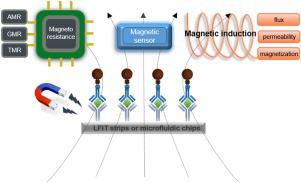Sensors and Actuators A: Physical ( IF 4.6 ) Pub Date : 2020-06-02 , DOI: 10.1016/j.sna.2020.112130 Bo Cao , Kan Wang , Hao Xu , Qi Qin , Jinchuan Yang , Wei Zheng , Qinghui Jin , Daxiang Cui

|
Immunoassay based on the detection of magnetic nanoparticles (MNPs) has drawn great attention in the point-of-care testing (POCT) fields. Benefiting from the unique magnetic properties of MNPs, magnetic immunoassay possesses many advantages with more complete information of the labels and less interference from background. The developments of magnetic sensor technologies play vital roles in the quantification of MNPs and determine the directions and prospects of magnetic immunoassay. In this review, two kinds of magnetic sensor technologies including magnetoresistance (MR) sensor technology and magnetic induction (MI) sensor technology are discussed and their fundamentals as well as the applications of lateral flow immunoassay test (LFIT) strips or microfluidic biochips are summarized. MR sensor technology achieves detection with high accuracy and sensitivity by measuring the stray fields from MNPs under external excitation magnetic field. And magnetic induction sensor technology mainly detects the change of several magnetic physical quantities to realize the quantification of MNPs. Their different operating principles, measurement mechanisms and detection performances are given focus. In the meantime, their merits as well as limitations in practical applications are elaborated and compared. Future developments of magnetic immunoassay are expected to design integrated sensors with greater functions, which can accommodate smart detection and mobile detection supporting high performance.
中文翻译:

用于即时检验的磁传感器技术的开发:基本原理,方法和应用
基于磁性纳米粒子(MNP)检测的免疫分析法在即时检测(POCT)领域引起了极大的关注。得益于MNP独特的磁性,磁性免疫测定法具有许多优点,其中标记信息更完整,背景干扰更少。磁传感器技术的发展在MNP定量中起着至关重要的作用,并确定了磁免疫测定的方向和前景。本文综述了磁阻(MR)传感器技术和磁感应(MI)传感器技术这两种磁传感器技术,并概述了它们的基本原理以及侧流免疫分析测试(LFIT)试纸或微流体生物芯片的应用。MR传感器技术通过在外部激励磁场下测量MNP的杂散场来实现高精度和灵敏的检测。磁感应传感器技术主要检测几种磁性物理量的变化,以实现对MNP的定量。重点介绍了它们的不同工作原理,测量机制和检测性能。同时,对它们的优缺点以及在实际应用中的局限性进行了阐述和比较。磁免疫测定法的未来发展有望设计出功能更强大的集成传感器,这些传感器可适应智能检测和支持高性能的移动检测。磁感应传感器技术主要检测几种磁性物理量的变化,以实现对MNP的定量。重点介绍了它们的不同工作原理,测量机制和检测性能。同时,对它们的优缺点以及在实际应用中的局限性进行了阐述和比较。磁免疫测定法的未来发展有望设计出功能更强大的集成传感器,这些传感器可适应智能检测和支持高性能的移动检测。磁感应传感器技术主要检测几种磁性物理量的变化,以实现对MNP的定量。重点介绍了它们的不同工作原理,测量机制和检测性能。同时,对它们的优缺点以及在实际应用中的局限性进行了阐述和比较。磁免疫测定法的未来发展有望设计出功能更强大的集成传感器,这些传感器可适应智能检测和支持高性能的移动检测。阐述并比较了它们的优缺点以及在实际应用中的局限性。磁免疫测定法的未来发展有望设计出功能更强大的集成传感器,这些传感器可适应智能检测和支持高性能的移动检测。阐述并比较了它们的优缺点以及在实际应用中的局限性。磁免疫测定法的未来发展有望设计出功能更强大的集成传感器,这些传感器可适应智能检测和支持高性能的移动检测。


























 京公网安备 11010802027423号
京公网安备 11010802027423号